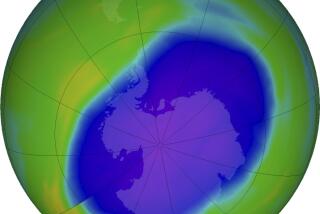Optimism From on High
- Share via
At last, there is some good news on the horizon.
The increase in emissions of chemicals that destroy the Earth’s protective ozone has lessened, according to new research from the National Oceanic and Atmospheric Administration. Worldwide emissions of the most widely used chlorofluorocarbons (CFCs) continue to increase but at a much slower rate than previously--less than half of what had been measured before.
If this trend continues, the buildup of these chemicals should stop before the year 2000. The worst of the ozone destruction should occur at about the same time. It will be then that the peak concentration of the chemicals, slowly wafting upward, reaches the stratosphere, where ozone depletion occurs. Afterward, ozone levels could begin to recover--but that process could take between 40 and 140 years, scientists say.
And there is much uncertainty about that recovery as well, in part because other ozone-depleting chemicals, such as the pesticide methyl bromide, are not yet fully regulated. Also, rising levels of carbon dioxide have spewed into the atmosphere from burning coal and other fossil fuels. In the lower atmosphere, the growth in carbon dioxide could warm the Earth--creating the so-called greenhouse effect. Higher up, the gas cools the stratosphere, possibly accelerating chlorine’s ability to deplete the ozone layer.
The ozone layer keeps the sun’s harmful ultraviolet rays from reaching the Earth. Unimpeded, those rays can cause skin cancer and cataracts and disrupt ecological processes.
CFCs have been used as cleaning solvents, as cooling agents for air conditioners and refrigerators and in the production of foam packaging and insulation.
Who’s responsible for the new atmospheric improvement? In large part, the makers of CFC-containing products who developed substitutes for the chemicals. Their action came in response to two recent international agreements that call for phasing out the use of CFCs by the end of 1995.
“That’s good news,” an Environmental Defense Fund scientist said of the new emissions findings. We couldn’t agree more.
More to Read
Sign up for Essential California
The most important California stories and recommendations in your inbox every morning.
You may occasionally receive promotional content from the Los Angeles Times.












